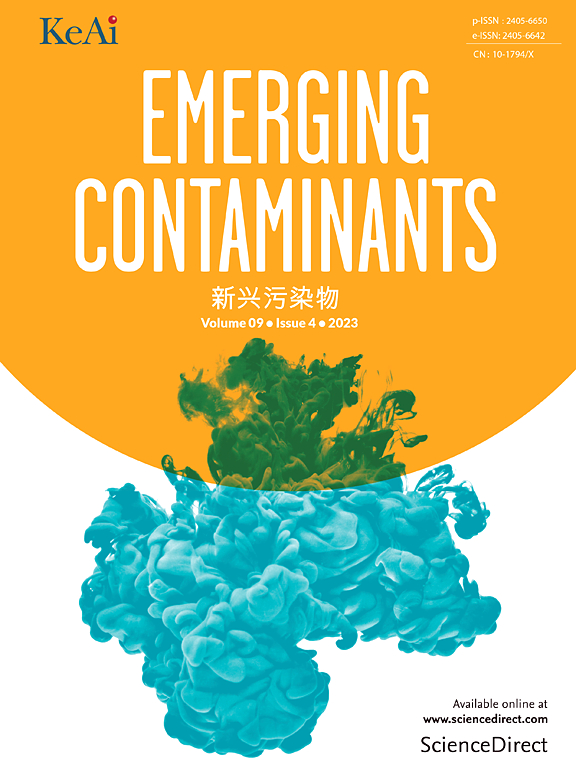Levels and risk assessment of dl-PCBs and dioxins in soils surrounded by cement plants from industrial areas of Colombia and Spain
IF 5.3
2区 环境科学与生态学
Q1 ENVIRONMENTAL SCIENCES
引用次数: 0
Abstract
This study investigates the concentrations of 17 PCDD/Fs and 12 dl-PCBs congeners in soil samples collected from industrial areas in Cartagena de Indias (Colombia) and Valencia (Spain). The aim is to assess the characteristic distribution patterns and the potential risk around cement plants within the selected locations, addressing the lack of data on PCDD/Fs and dl-PCBs in soils from the two studied areas. Soil samples were analysed using gas chromatography coupled to high-resolution mass spectrometry (GC-HRMS). The PCDD/Fs concentrations varied from 0.01 pg g−1 dw to 520.43 pg g−1 dw in Colombia and from 0.01 pg g−1 dw to 150.48 pg g−1 dw in Spain. For dl-PCBs, levels ranged from 0.03 pg g−1 dw to 1611.83 pg g−1 dw in Colombia and from 0.06 to 189.64 pg g−1 dw in Spain. Despite the differences observed in concentration terms between the two areas studied, the same pattern of congeners was observed. The hazard index (HI) values for exposure of adults and children in soil were, in overall, smaller than one (HI < 1), while the total cancer risk (TCR) values exceeded the acceptable risk value of 10−6, which indicate probable non-carcinogenic and carcinogenic risks resulting from exposure to PCDD/Fs and dl-PCBs in these areas. The ecological risk was assessed using the Contamination Factor (CF) and the Ecological Risk Index (ERI), revealing significant contamination in the studied areas.

哥伦比亚和西班牙工业区水泥厂周围土壤中 dl-PCB 和二恶英的含量和风险评估
本研究调查了从卡塔赫纳德印第亚斯(哥伦比亚)和巴伦西亚(西班牙)工业区采集的土壤样本中 17 种多氯二苯并对二恶英和多氯二苯并呋喃以及 12 种 dl-PCBs 同系物的浓度。目的是评估选定地点内水泥厂周围的特征分布模式和潜在风险,解决两个研究地区土壤中多氯二苯并对二恶英/多氯二苯并呋喃和二氯苯并芘数据缺乏的问题。土壤样本采用气相色谱-高分辨质谱法(GC-HRMS)进行分析。哥伦比亚的多氯二苯并对二恶英和多氯二苯并呋喃浓度从 0.01 pg g-1 dw 到 520.43 pg g-1 dw 不等,西班牙的多氯二苯并对二恶英和多氯二苯并呋喃浓度从 0.01 pg g-1 dw 到 150.48 pg g-1 dw 不等。哥伦比亚的 dl-PCB 含量从 0.03 pg g-1 dw 到 1611.83 pg g-1 dw 不等,西班牙的 dl-PCB 含量从 0.06 pg g-1 dw 到 189.64 pg g-1 dw 不等。尽管所研究的两个地区在浓度方面存在差异,但观察到的同系物模式相同。总体而言,成人和儿童暴露于土壤中的危害指数(HI)值小于 1(HI < 1),而总致癌风险(TCR)值则超过了 10-6 的可接受风险值,这表明在这些地区暴露于多氯二苯并对二恶英/多氯二苯并呋喃和 dl-PCBs 可能存在非致癌和致癌风险。生态风险采用污染因子和生态风险指数进行评估,结果表明研究区域存在严重污染。
本文章由计算机程序翻译,如有差异,请以英文原文为准。
求助全文
约1分钟内获得全文
求助全文
来源期刊

Emerging Contaminants
Medicine-Public Health, Environmental and Occupational Health
CiteScore
10.00
自引率
6.70%
发文量
35
审稿时长
44 days
期刊介绍:
Emerging Contaminants is an outlet for world-leading research addressing problems associated with environmental contamination caused by emerging contaminants and their solutions. Emerging contaminants are defined as chemicals that are not currently (or have been only recently) regulated and about which there exist concerns regarding their impact on human or ecological health. Examples of emerging contaminants include disinfection by-products, pharmaceutical and personal care products, persistent organic chemicals, and mercury etc. as well as their degradation products. We encourage papers addressing science that facilitates greater understanding of the nature, extent, and impacts of the presence of emerging contaminants in the environment; technology that exploits original principles to reduce and control their environmental presence; as well as the development, implementation and efficacy of national and international policies to protect human health and the environment from emerging contaminants.
 求助内容:
求助内容: 应助结果提醒方式:
应助结果提醒方式:


